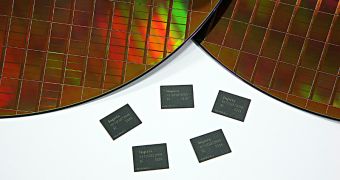It seems that, while not exactly over, the troubles on the NAND Flash market have more or less settled down, at least to some extent, because spot prices of NAND Chips managed to stabilize.
The past few weeks have been filled with reports about how the semiconductor industry is not doing very well.
Both the DRAM and NAND sectors have been experiencing continuous drops in average selling prices (ASPs).
DRAM seems to be having it worse, as prices of such chips and modules are set to keep falling until the first quarter of 2010.
NAND, on the other hand, while it is expected to see a price fall of 35% in 2011, seems to have managed to hit a balance.
What this means is that contract prices for some of the more common chips stabilized in late November, or at least fell by very little.
For example, 32 Gb 3-bit per cell MLC slid down 1.02%, to US$3.90 on average, while 64 Gb 3-bit per cell MLC slid 0.22%, to US$8.90.
Also, MLC (multi-level cell) chips of 64 Gb NAND managed not to fall and ended up selling for US$9.10 in late November, which means they got 1.09% cheaper.
This is interesting, considering that those very same chips decreased in price by over 7% in the first half of the same month.
16 Gb and 8 Gb MLC chips are the ones that stayed flat, at US$3.38 and US$3.26 on average, respectively.
Finally, 32 Gb MLC NAND actually managed to go up to US$4.98, which corresponds to an increase of 1.01%.
As before, the main forces driving the NAND Flash memory chip market are the markets segments of smartphones and tablet PCs.
Considering that slates have yet to truly take off, it remains to be seen just how demand escalates next year and if it does jump enough for the NAND industry to recover.

 14 DAY TRIAL //
14 DAY TRIAL //